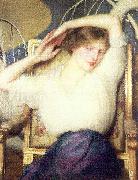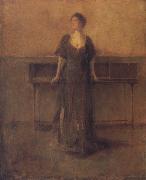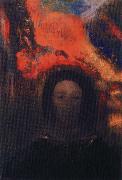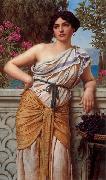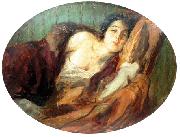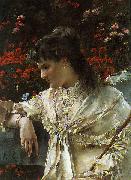Wholesale Oil Painting No Minimum |
|||||||||||
|
|
|||||||||||

|
|||||||||||
|
|
|
||||||||
Paxton, William McGregorAmerican Painter, 1869-1941 was an American Impressionist painter. Born in Baltimore, the Paxton family came to Newton Corner in the mid-1870s, where William's father James established himself as a caterer. At 18, William won a scholarship to attend the Cowles Art School, where he began his art studies with Dennis Miller Bunker. Later he studied with Jean-L??on G??rôme in Paris and, on his return to Boston, with Joseph DeCamp at Cowles. There he met his future wife Elizabeth Okie, who also was studying with DeCamp. After their marriage, William and Elizabeth lived with his parents at 43 Elmwood Street, and later bought a house at 19 Montvale Road in Newton Centre. Paxton, who is best known as a portrait painter, taught at the Museum School from 1906 to 1913. Along with other well known artists of the era, including Edmund Charles Tarbell and Frank Benson, he is identified with the Boston School. Like many of his Boston colleagues, Paxton found inspiration in the work of the seventeenth-century Dutch painter Johannes Vermeer. Paxton was fascinated not only with Vermeer's imagery, but also with the system of optics he employed. He studied Vermeer's works closely, and discovered that only one area in his compositions was entirely in focus, while the rest were somewhat blurred. Paxton ascribed this peculiarity to "binocular vision," crediting Vermeer with recording the slightly different point of view of each individual eye that combine in human sight. He began to employ this system in his own work, including The New Necklace, where only the gold beads are sharply defined while the rest of the objects in the composition have softer, blurrier edges. |
||||||||
|
|
||||||||
Reverie
Reverie Painting ID:: 19795 |
1917
Oil on canvas. 1917 Oil on canvas. |
|||||||
|
|
||||||||
Frederick Leighton1830-1896 He was an English painter and sculptor. His works depicted historical, biblical and classical subject matter. Leighton was born in Scarborough to a family in the import and export business. He was educated at University College School, London. He then received his artistic training on the European continent, first from Eduard Von Steinle and then from Giovanni Costa. When in Florence, aged 24, where he studied at the Accademia di Belle Arti, he painted the procession of the Cimabue Madonna through the Borgo Allegri. He lived in Paris from 1855 to 1859, where he met Ingres, Delacroix, Corot and Millet. Flaming JuneIn 1860, he moved to London, where he associated with the Pre-Raphaelites. He designed Elizabeth Barrett Browning's tomb for Robert Browning in the English Cemetery, Florence in 1861. In 1864 he became an associate of the Royal Academy and in 1878 he became its President (1878?C96). His 1877 sculpture, Athlete Wrestling with a Python, was considered at its time to inaugurate a renaissance in contemporary British sculpture, referred to as the New Sculpture. His paintings represented Britain at the great 1900 Paris Exhibition. Icarus and DaedalusLeighton was knighted at Windsor in 1878, and was created a baronet eight years later. He was the first painter to be given a peerage, in the New Year Honours List of 1896. |
||||||||
|
|
||||||||
|
|
Reverie
Reverie Painting ID:: 37672 |
mk127
31x13
Oil on canvas
mk127 31x13 Oil on canvas |
||||||
|
|
||||||||
Thomas Wilmer Dewing1851-1938 Thomas Wilmer Dewing Gallery was an American painter working at the turn of the 20th century. He was born in Newton Lower Falls, Massachusetts. He studied at the Acad??mie Julian in Paris, and later settled into a studio in New York City. He married Maria Oakey Dewing, an accomplished painter with extensive formal art training and familial links with the art world. He is best known for his tonalist paintings, a sub-genre of American art that was rooted in English Aestheticism. Dewing's preferred vehicle of artistic expression is the female figure. Often seated playing instruments, writing letters, or engaged in other impassive actions and situated in gauzy, dreamy interiors, the figures remain remote and distant to the viewer. These scenes are infused with a color that pervades the entire picture, setting tone and mood. The ethereal delicacy and subtle color harmonies of Dewing's paintings have not met with universal approval: some feminist critics have lambasted Dewing's work as being misogynistic; he rarely painted anything other than the female figure, vacant of expression, languishing in sumptuous clothing. Tonalism quickly came to be considered outdated with the advent of modernism and abstraction in art, though Dewing was successful in his own day. His art was considered extremely elegant, and has undergone a subtle revival in the last 10 years or so. Dewing was a member of the Ten American Painters, a group of American Impressionists who seceded from the Society of American Artists in 1897. He spent his summers at the art colony in Cornish, New Hampshire. |
||||||||
|
|
||||||||
|
|
Reverie
Reverie Painting ID:: 39299 |
mk146
before 1928
mk146 before 1928 |
||||||
|
|
||||||||
Jean Baptiste Camille Corot1796-1875 Corot Locations French painter, draughtsman and printmaker. After a classical education at the College de Rouen, where he did not distinguish himself, and an unsuccessful apprenticeship with two drapers, Corot was allowed to devote himself to painting at the age of 26. He was given some money that had been intended for his sister, who had died in 1821, and this, together with what we must assume was his family continued generosity, freed him from financial worries and from having to sell his paintings to earn a living. Corot chose to follow a modified academic course of training. He did not enrol in the Ecole des Beaux-Arts but studied instead with Achille Etna Michallon and, after Michallon death in 1822, with Jean-Victor Bertin. Both had been pupils of Pierre-Henri Valenciennes, and, although in later years Corot denied that he had learnt anything of value from his teachers, his career as a whole shows his attachment to the principles of historic landscape painting which they professed. |
||||||||
|
|
||||||||
|
|
Reverie
Reverie Painting ID:: 41293 |
mk161
Panel
mk161 Panel |
||||||
|
|
||||||||
Edvard MunchNorwegian 1863-1944 Edvard Munch Locations Edvard Munch (pronounced , December 12, 1863 ?C January 23, 1944) was a Norwegian Symbolist painter, printmaker, and an important forerunner of expressionistic art. His best-known composition, The Scream is one of the pieces in a series titled The Frieze of Life, in which Munch explored the themes of life, love, fear, death, and melancholy. Edvard Munch was born in a rustic farmhouse in the village of Adalsbruk in Loten, Norway to Christian Munch, the son of a prominent priest. Christian was a doctor and medical officer, who married Laura Cathrine Bjølstad, a woman half his age, in 1861. Edvard had an older sister, Johanne Sophie (born 1862), and three younger siblings: Peter Andreas (born 1865), Laura Cathrine (born 1867), and Inger Marie (born 1868). Both Sophie and Edvard appear to have gotten their art talent from their mother. Edvard Munch was related to painter Jacob Munch (1776?C1839) and historian Peter Andreas Munch (1810?C1863). The family moved to Kristiania (now Oslo) in 1864 when Christian Munch was appointed medical officer at Akershus Fortress. Edvard??s mother died of tuberculosis in 1868, as did Munch's favorite sister Johanne Sophie in 1877. After their mother's death, the Munch siblings were raised by their father and by their aunt Karen. Often ill for much of the winters and kept out of school, Edvard would draw to keep himself occupied. He also received tutoring from his school mates and his aunt. Christian Munch also instructed his son in history and literature, and entertained the children with vivid ghost stories and tales of Edgar Allan Poe. Christian??s positive behavior toward his children, however, was overshadowed by his morbid pietism. Munch wrote, ??My father was temperamentally nervous and obsessively religious??to the point of psychoneurosis. From him I inherited the seeds of madness. The angles of fear, sorrow, and death stood by my side since the day I was born.?? Christian reprimanded his children by telling them that their mother was looking down from heaven and grieving over their misbehavior. The oppressive religious milieu, plus Edvard??s poor health and the vivid ghost stories, helped inspire macabre visions and nightmares in Edvard, who felt death constantly advancing on him. One of Munch's younger sisters was diagnosed with mental illness at an early age. Of the five siblings only Andreas married, but he died a few months after the wedding. Munch would later write, "I inherited two of mankind's most frightful enemies??the heritage of consumption and insanity." Christian Munch??s military pay was very low, and his attempts at developing a private side practice failed, keeping his family in perrenial poverty. They moved frequently from one sordid flat to another. Munch??s early drawings and watercolors depicted these interiors, and the individual objects such as medicine bottles and drawing implements, plus some landscapes. By his teens, art dominated Munch??s interests. At thirteen, Munch has his first exposure to other artists at the newly formed Art Association, were he admired the work of the Norwegian landscape school, and where he returned to copy the paintings, and soon he began to paint in oils. |
||||||||
|
|
||||||||
|
|
reverie
reverie Painting ID:: 56644 |
mk248 odilon redon var grafisk konstnar ocb skribent, forutom en stor symbolistmalare. influerad av courbet ocb corot lyckads ban undfly effekterna av en olycklig barndom med epilepsi. mk248 odilon redon var grafisk konstnar ocb skribent, forutom en stor symbolistmalare. influerad av courbet ocb corot lyckads ban undfly effekterna av en olycklig barndom med epilepsi. |
||||||
|
|
||||||||
John William GodwardEnglish 1861-1922 Godward was a Victorian Neo-classicist, and therefore a follower in theory of Frederic Leighton. However, he is more closely allied stylistically to Sir Lawrence Alma-Tadema, with whom he shared a penchant for the rendering of Classical architecture, in particular, static landscape features constructed from marble. The vast majority of Godward's extant images feature women in Classical dress, posed against these landscape features, though there are some semi-nude and fully nude figures included in his oeuvre (a notable example being In The Tepidarium (1913), a title shared with a controversial Alma-Tadema painting of the same subject that resides in the Lady Lever Art Gallery). The titles reflect Godward's source of inspiration: Classical civilisation, most notably that of Ancient Rome (again a subject binding Godward closely to Alma-Tadema artistically), though Ancient Greece sometimes features, thus providing artistic ties, albeit of a more limited extent, with Leighton. Given that Classical scholarship was more widespread among the potential audience for his paintings during his lifetime than in the present day, meticulous research of detail was important in order to attain a standing as an artist in this genre. Alma-Tadema was, as well as a painter, an archaeologist who attended historical sites and collected artefacts that were later used in his paintings: Godward, too, studied such details as architecture and dress, in order to ensure that his works bore the stamp of authenticity. In addition, Godward painstakingly and meticulously rendered those other important features in his paintings, animal skins (the paintings Noon Day Rest (1910) and A Cool Retreat (1910) contain superb examples of such rendition) and wild flowers (Nerissa (1906), illustrated above, and Summer Flowers (1903) are again excellent examples of this). The appearance of beautiful women in studied poses in so many of Godward's canvases causes many newcomers to his works to categorise him mistakenly as being Pre-Raphaelite, particularly as his palette is often a vibrantly colourful one. However, the choice of subject matter (ancient civilisation versus, for example, Arthurian legend) is more properly that of the Victorian Neoclassicist: however, it is appropriate to comment that in common with numerous painters contemporary with him, Godward was a 'High Victorian Dreamer', producing beautiful images of a world which, it must be said, was idealised and romanticised, and which in the case of both Godward and Alma-Tadema came to be criticised as a world-view of 'Victorians in togas'. |
||||||||
|
|
||||||||
|
|
Reverie
Reverie Painting ID:: 68050 |
1912(1912)
Oil on canvas
50 X 30 inches (127 X 76.2 cm)
1912(1912) Oil on canvas 50 X 30 inches (127 X 76.2 cm) |
||||||
|
|
||||||||
Nicolae Vermont(October 10, 1866 - June 14, 1932) was a Romanian realist painter, graphic artist and muralist. He was noted for his wide range of subjects and his interest in social issues, and was an associate of the post-Impressionists Ştefan Luchian and Constantin Artachino, as well as a friend of the controversial art collector and political figure Alexandru Bogdan-Piteşti. Born in Bacău, Vermont belonged to the Jewish community. Late in his life, Vermont abandoned Judaism and converted to the Romanian Orthodox Church. He began his career in 1884, as a contributor to the journal Universul, while studying with Theodor Aman at the Academy of Fine Arts in Bucharest (graduated 1886). Vermont completed his training at the Munich Akademie der Bildenden Kenste (1893). He was able to attend the latter institution after being endorsed by the major Romanian artist Nicolae Grigorescu. |
||||||||
|
|
||||||||
|
|
Reverie
Reverie Painting ID:: 74587 |
Reverie (1920)
Reverie (1920) |
||||||
|
|
||||||||
Alfred Stevens1823-1906 Alfred Stevens Galleries Flemish Alfred Emile Stevens (May 11, 1823 - August 29, 1906) , Belgian painter, was born in Brussels. El??gants sur les BoulevardsHis father, an old officer in the service of William I of the Netherlands, was passionately fond of pictures, and readily allowed his son to draw in the studio of François Navez, director of the Brussels Academy. In 1844 Stevens went to Paris and worked under the instructing of Camille Roqueplan, a friend of his father's; he also attended the classes at the Ecole des Beaux-Arts, where Ingres was then professor. In 1849 he painted at Brussels his first picture, A Soldier in Trouble, and in the same year went back to Paris, where he definitely settled, and exhibited in the Salons. He then painted Ash-Wednesday Morning, Burghers and Country People finding at Daybreak the Body of a Murdered Gentleman, An Artist in Despair, and The Love of Gold. Allegory of the Night MSK, Oostende, BelgiumIn 1855 he exhibited at the Antwerp Salon a little picture called At Home, which showed the painter's bent towards depicting ladies of fashion. At the Great Exhibition in Paris, 1855, his contributions were remarkable, but in 1857 he returned to graceful female subjects, and his path thenceforth was clear before him. At the Great Exhibition of 1867 he was seen in a brilliant variety of works in the manner he had made his own, sending eighteen exquisite paintings; among them were the Lady in Pink (in the Brussels Gallery), Consolation, Every Good Fortune, Miss Fauvette, Ophelia, and India in Paris. At the Paris International Exhibitions of 1878 and 1889, and at the Historical Exhibition of Belgian Art, Brussels, 1880, he exhibited The Four Seasons (in the Palace at Brussels), The Parisian Sphinx, The Japanese Mask, The Japanese Robe, and The Lady-bird (Brussels Gallery). "Alfred Stevens is one of the race of great painters," wrote Camille Lemonnier, "and like them he takes immense pains with the execution of his work." The example of his finished technique was salutary, not merely to his brethren in Belgium, but to many foreign painters who received encouragement from the study of his method. The brother of Alfred Stevens, Joseph Stevens, was a great painter of dogs and dog life. See J. du Jardin, L'Art flamand; Camille Lemonnier, Histoire des beaux arts en Belgique. |
||||||||
|
|
||||||||
|
|
Reverie
Reverie Painting ID:: 94256 |
circa 1878(1878)
Medium oil on canvas
cjr circa 1878(1878) Medium oil on canvas cjr |
||||||
|
|
||||||||
|
Alfred Stevens 1823-1906 Alfred Stevens Galleries Flemish Alfred Emile Stevens (May 11, 1823 - August 29, 1906) , Belgian painter, was born in Brussels. El??gants sur les BoulevardsHis father, an old officer in the service of William I of the Netherlands, was passionately fond of pictures, and readily allowed his son to draw in the studio of François Navez, director of the Brussels Academy. In 1844 Stevens went to Paris and worked under the instructing of Camille Roqueplan, a friend of his father's; he also attended the classes at the Ecole des Beaux-Arts, where Ingres was then professor. In 1849 he painted at Brussels his first picture, A Soldier in Trouble, and in the same year went back to Paris, where he definitely settled, and exhibited in the Salons. He then painted Ash-Wednesday Morning, Burghers and Country People finding at Daybreak the Body of a Murdered Gentleman, An Artist in Despair, and The Love of Gold. Allegory of the Night MSK, Oostende, BelgiumIn 1855 he exhibited at the Antwerp Salon a little picture called At Home, which showed the painter's bent towards depicting ladies of fashion. At the Great Exhibition in Paris, 1855, his contributions were remarkable, but in 1857 he returned to graceful female subjects, and his path thenceforth was clear before him. At the Great Exhibition of 1867 he was seen in a brilliant variety of works in the manner he had made his own, sending eighteen exquisite paintings; among them were the Lady in Pink (in the Brussels Gallery), Consolation, Every Good Fortune, Miss Fauvette, Ophelia, and India in Paris. At the Paris International Exhibitions of 1878 and 1889, and at the Historical Exhibition of Belgian Art, Brussels, 1880, he exhibited The Four Seasons (in the Palace at Brussels), The Parisian Sphinx, The Japanese Mask, The Japanese Robe, and The Lady-bird (Brussels Gallery). "Alfred Stevens is one of the race of great painters," wrote Camille Lemonnier, "and like them he takes immense pains with the execution of his work." The example of his finished technique was salutary, not merely to his brethren in Belgium, but to many foreign painters who received encouragement from the study of his method. The brother of Alfred Stevens, Joseph Stevens, was a great painter of dogs and dog life. See J. du Jardin, L'Art flamand; Camille Lemonnier, Histoire des beaux arts en Belgique. Reverie circa 1878(1878) Medium oil on canvas cjr |
||||||||
|
|
||||||||
|
Prev Next
|
||||||||
|
|
||||||||
|
Related Paintings to Alfred Stevens :. |
||||||||
|
|
||||||||
|
CONTACT US |
